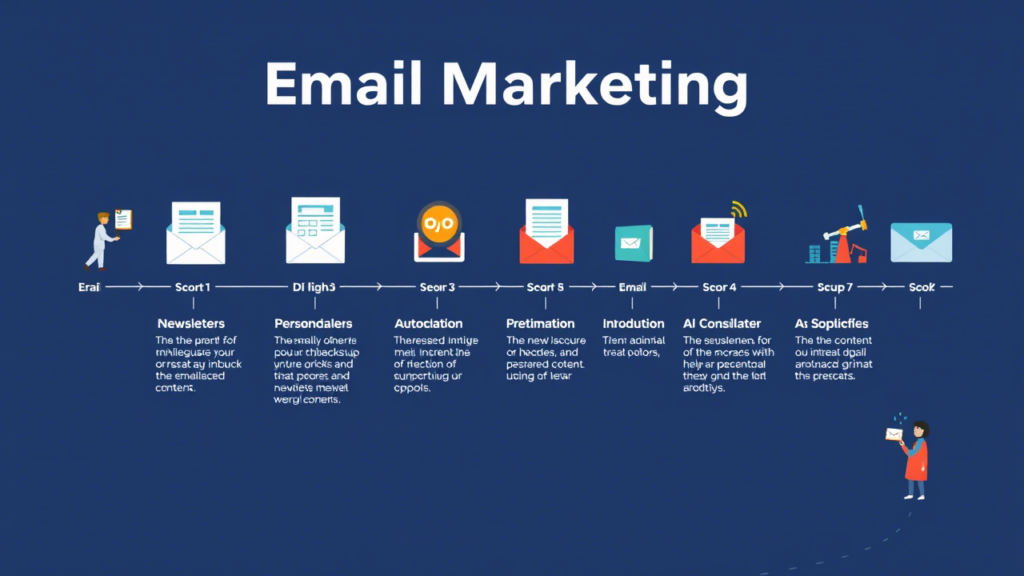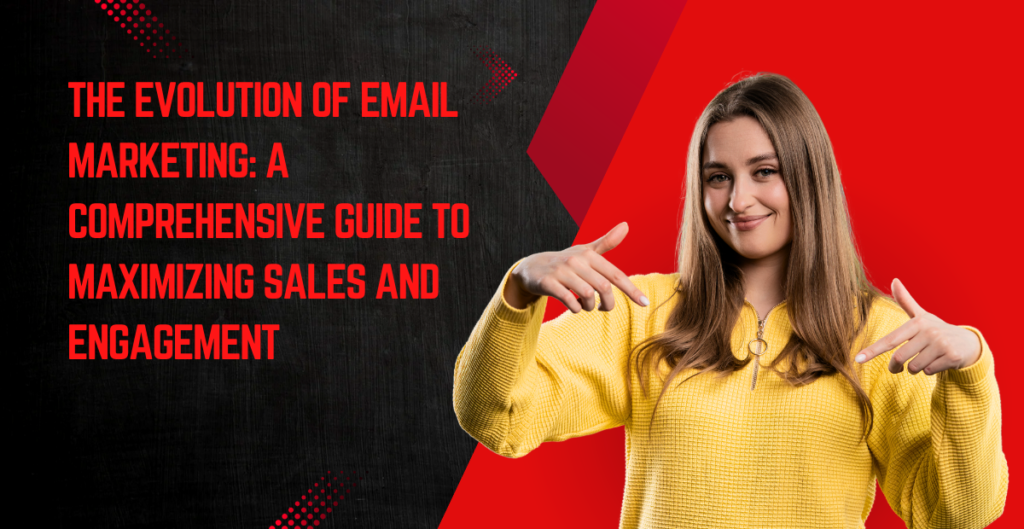The Evolution of Email Marketing
In the ever-evolving world of digital marketing, The Evolution of Email Marketing remains one of the most powerful tools for businesses looking to connect with their audience. However, as consumer preferences change and technology advances, it’s crucial to adapt traditional strategies to stay ahead of the curve. This article delves into a modernized approach to email marketing and sales automation, offering actionable insights and strategies that can help you enhance customer engagement, boost conversions, and streamline your operations.
Table of Contents
The Evolution of Email Marketing
Understanding the Foundations of The Evolution of Email Marketing
The Evolution of Email Marketing has long been a cornerstone of digital marketing strategies. Its ability to deliver personalized messages directly to consumers’ inboxes makes it an invaluable tool for building relationships and driving sales. However, the traditional model of daily live emails promoting single products at a time comes with its own set of challenges. It demands constant content creation, limits revenue streams by focusing on one product at a time, and relies heavily on scarcity tactics to drive conversions.
To overcome these limitations, marketers are increasingly turning to automated systems that replicate the success of manual approaches while introducing elements of scalability and efficiency. By leveraging segmentation, static content pages, and self-guided journeys, businesses can create more engaging and effective campaigns that cater to diverse customer needs.
Key Components of Modern The Evolution of Email Marketing
- Segmentation : Tailoring content to specific audience segments ensures relevance and increases engagement.
- Static Content Pages : Redirecting subscribers to web pages hosting repurposed email content allows for better tracking and optimization.
- Scarcity Mechanism : Implementing real-time timers enhances urgency without overwhelming users.
- Exit Pop-Ups : Guiding users toward additional content or questions encourages further exploration.
- Automated Journey : Creating a self-guided experience reduces pressure and improves user satisfaction.
- Evergreen Structure : Ensuring all content and offers remain accessible streamlines the onboarding process for new leads.
Segmenting Your Audience Effectively
One of the cornerstones of successful The Evolution of Email Marketing is understanding and segmenting your audience. By dividing your subscribers into distinct groups based on shared characteristics, you can tailor your messaging to address their unique needs and preferences. This not only increases the likelihood of conversion but also fosters stronger relationships with your audience.
How to Segment Your Audience
- Demographics : Age, gender, location, and income level can provide valuable insights into your audience’s buying behavior.
- Behavioral Data : Analyze past interactions such as purchase history, email opens, and click-through rates to identify patterns.
- Psychographics : Understand your audience’s interests, values, and lifestyle choices to create more resonant content.
- Engagement Level : Segment users based on their level of engagement, from active participants to inactive leads.
| Segmentation Criteria | Example |
|---|---|
| Demographics | Users aged 18-35 living in urban areas |
| Behavioral Data | Subscribers who opened at least 5 emails in the last month |
| Psychographics | Fitness enthusiasts interested in healthy living |
| Engagement Level | Active users vs. inactive leads |
By implementing these segmentation strategies, you can craft highly targeted campaigns that resonate with each group, increasing the effectiveness of your email marketing efforts.

Leveraging Static Content Pages
Redirecting subscribers to static content pages instead of sending traditional emails offers numerous advantages. These pages allow you to repurpose your best-performing The Evolution of Email Marketingcontent, optimizing it for readability and conversion. Additionally, they enable better tracking and analysis of user behavior, providing valuable insights for future campaigns.
Benefits of Static Content Pages
- Improved Readability : Web pages offer a cleaner format compared to cluttered email interfaces.
- Enhanced Tracking : Analytics tools can provide detailed insights into user interactions and engagement metrics.
- Optimized Conversion Paths : Strategically placed calls to action (CTAs) can guide users toward desired actions more effectively.
| Benefit | Description |
|---|---|
| Improved Readability | Cleaner layout and better formatting options lead to higher engagement rates. |
| Enhanced Tracking | Detailed analytics help identify which elements drive the most traffic and conversions. |
| Optimized Conversion Paths | Carefully crafted CTAs increase the likelihood of users taking desired actions. |
When designing static content pages, consider incorporating multimedia elements such as images, videos, and interactive features to make the content more engaging. Additionally, ensure that your CTAs are clear and compelling, encouraging users to take the next step in their journey.
The Evolution of Email Marketing
Enhancing Urgency with Scarcity Mechanisms
Creating a sense of urgency is a proven technique for boosting conversions. While fake countdown timers have been used in the past, modern approaches favor real-time timers based on individual user sessions. This method enhances credibility and maintains user trust while still driving immediate action.
Best Practices for Implementing Scarcity Mechanisms
- Real-Time Timers : Use session-based timers to create a genuine sense of urgency without resorting to deceptive practices.
- Limited-Time Offers : Highlight exclusive deals available for a short period to encourage quick decisions.
- Social Proof : Display testimonials or reviews from satisfied customers to build confidence in your offerings.
| Strategy | Implementation Tip |
|---|---|
| Real-Time Timers | Integrate timers that reset after each user session ends. |
| Limited-Time Offers | Clearly communicate the duration of the offer in all promotional materials. |
| Social Proof | Include dynamic widgets showing recent purchases or positive feedback. |
By combining these strategies, you can create a compelling case for immediate action without alienating your audience.

The Evolution of Email Marketing
Utilizing Exit Pop-Ups for Enhanced Engagement
Exit pop-ups have become a staple in modern marketing due to their ability to recapture attention and guide users toward additional content or products. Unlike aggressive sales pitches, well-designed exit pop-ups offer value by addressing unanswered questions or providing relevant resources.
Designing Effective Exit Pop-Ups
- Focus on Value : Ensure that your pop-up provides useful information or solutions rather than just pushing sales.
- Timing Matters : Trigger pop-ups at the right moment, such as when a user moves their cursor toward the close button.
- Personalization : Customize messages based on user behavior or segment data to increase relevance.
| Design Element | Best Practice |
|---|---|
| Focus on Value | Offer free guides, tutorials, or answers to common questions. |
| Timing Matters | Avoid interrupting users too early; wait until they show signs of leaving. |
| Personalization | Use data to tailor messages to specific user segments or behaviors. |
Implementing these techniques can significantly improve the effectiveness of your exit pop-ups, turning potential losses into opportunities for engagement.
Automating the Customer Journey
Creating an automated customer journey allows users to navigate through a series of articles or resources leading to various product offerings. This self-guided approach empowers users to engage with content at their own pace, reducing feelings of pressure and enhancing overall satisfaction.
Steps to Create an Automated Journey
- Identify Key Touchpoints : Determine the critical stages in your customer journey where automation can add value.
- Develop Engaging Content : Craft informative and entertaining content that naturally leads users toward desired actions.
- Set Up Triggers : Establish rules for when and how users progress through different stages of the journey.
- Monitor and Optimize : Continuously track performance metrics and refine your strategy based on user feedback and behavior.
| Step | Action |
|---|---|
| Identify Key Touchpoints | Map out the stages of the customer journey where automation can be applied. |
| Develop Engaging Content | Create high-quality content that aligns with user interests and goals. |
| Set Up Triggers | Define conditions under which users move between stages of the journey. |
| Monitor and Optimize | Regularly review analytics and adjust strategies for maximum impact. |
By following these steps, you can create a seamless and engaging experience that drives both conversions and customer loyalty.
Conclusion:The Evolution of Email Marketing
Modern email marketing is about more than just sending out newsletters—it’s about creating meaningful connections with your audience through personalized, automated, and evergreen content. By implementing advanced segmentation, leveraging static content pages, enhancing urgency with scarcity mechanisms, utilizing exit pop-ups, and automating the customer journey, you can revolutionize your marketing strategy and achieve greater success in today’s competitive landscape.
Adopting these techniques not only addresses the limitations of traditional methods but also positions your business for sustained growth and innovation. Whether you’re a seasoned marketer or just starting out, embracing this evolution in email marketing will undoubtedly yield significant benefits.
Frequently Asked Questions (FAQ):The Evolution of Email Marketing
- How do I start segmenting my audience effectively?
- Begin by collecting demographic, behavioral, and psychographic data about your subscribers. Use this information to divide them into distinct groups based on shared characteristics.
- What are some best practices for designing static content pages?
- Focus on readability, incorporate multimedia elements, and strategically place calls to action. Ensure your pages are optimized for both desktop and mobile devices.
- Can I use AI tools to enhance my email marketing efforts?
- Absolutely! AI tools can assist with content generation, personalization, and refining calls to action, helping you create more effective campaigns with less effort.
- How often should I update my automated customer journey?
- Regular updates are essential to keep your content fresh and relevant. Aim to review and optimize your journey quarterly, adjusting based on user feedback and performance metrics.

